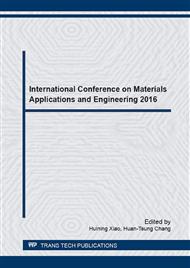[1]
McKenney PT, Driks A and Eichenberger P. The Bacillus subtilis endospore: assembly and functions of the multilayered coat. Nat. Rev. Microbiol. 11 (2013) 33-44.
DOI: 10.1038/nrmicro2921
Google Scholar
[2]
Kato T, Maeda K, Kasuya H and Matsuda T. Complete growth inhibition of Bacillus subtilis by nisin-producing Lactococci in fermented soybeans. Biosci., Biotechnol. and Biochem. 63 (1999) 642-647.
DOI: 10.1271/bbb.63.642
Google Scholar
[3]
Sugimoto T and Shoji H. Indigestible dextrin is an excellent inducer for α-amylase, α-glucosidase and glucoamylase production in a submerged culture of Aspergillus oryzae. Biotechnol. Lett. 34 (2012) 347-351.
DOI: 10.1007/s10529-011-0777-3
Google Scholar
[4]
Parekh J and Chanda S. Antibacterial and phytochemical studies on twelve species of Indian medicinal plants. Afri. J. Biomedical. Res. 10 (2007) 175-181.
DOI: 10.4314/ajbr.v10i2.50624
Google Scholar
[5]
Chen Y, Wong RWK, Seneviratne CJ, Hägg U, Mcgrath C, Samaranayake LP and Kao R. The antimicrobial efficacy of Fructus mume extract on orthodontic bracket: A monospecies-biofilm model study in vitro. Arch. Oral Biol. 56 (2011) 16-21.
DOI: 10.1016/j.archoralbio.2010.08.006
Google Scholar
[6]
Kong W, Xing X, Xiao X, Zhao Y, Wei J, Wang J, Yang R and Yang M. Effect of berberine on Escherichia coli, Bacillus subtilis, and their mixtures as determined by isothermal microcalorimetry. Appl. Microbiol. Biotechnol. 96 (2012) 503-510.
DOI: 10.1007/s00253-012-4302-y
Google Scholar
[7]
Georgopoulou M, Kontakiotis E, Nakou M. Evaluation of the antimicrobial effectiveness of citric acid and sodium hypochlorite on the anaerobic flora of the infected root canal. Inter. Endo. J. 27 (1994) 139-143.
DOI: 10.1111/j.1365-2591.1994.tb00243.x
Google Scholar
[8]
Raybaudi-Massilia RM, Mosqueda-Melgar J, Martín-Belloso O. Antimicrobial activity of malic acid against Listeria monocytogenes, Salmonella Enteritidis and Escherichia coli O157: H7 in apple, pear and melon juices. Food Control. 20 (2009) 105-112.
DOI: 10.1016/j.foodcont.2008.02.009
Google Scholar
[9]
Anderson R. Assessment of the roles of vitamin C, vitamin E and β-carotene in the modulation of oxidant stress mediated by cigarette smoke-activated phagocytes. Am. J. Clin. Nutr. 53 (1991) 358-361.
DOI: 10.1093/ajcn/53.1.358s
Google Scholar
[10]
Yan D, Jin C, Xiao XH, Dong XP. Antimicrobial properties of berberines alkaloids in Coptis chinensis Franch by microcalorimetry. J. Biochem. Biophysi. Methods. 70 (2008) 845-849.
DOI: 10.1016/j.jbbm.2007.07.009
Google Scholar
[11]
Seneviratne CJ, Wong RWK, Samaranayake LP. Potent anti–microbial activity of traditional Chinese medicine herbs against Candida species. Mycoses. 51 (2008) 30-34.
DOI: 10.1111/j.1439-0507.2007.01431.x
Google Scholar
[12]
Yu HH, Kim KJ, Cha JD, Kim HK, Lee YE, Choi NY, You YO. Antimicrobial activity of berberine alone and in combination with ampicillin or oxacillin against methicillin-resistant Staphylococcus aureus. J. Med. Food. 8 (2005) 454-461.
DOI: 10.1089/jmf.2005.8.454
Google Scholar
[13]
Farag RS, Daw ZY, Hewedi FM, El-Baroty GSA. Antimicrobial activity of some Egyptian spice essential oils. J. Food Prot. 52 (1989) 665–667.
DOI: 10.4315/0362-028x-52.9.665
Google Scholar
[14]
Koutsoudaki C, Krsek M, Rodger A. Chemical Composition and Antibacterial Activity of the Essential Oil and the Gum of Pistacia lentiscus Var. chia. J. Agric. Food Chem. 53 (2005) 7681–7685.
DOI: 10.1021/jf050639s
Google Scholar


